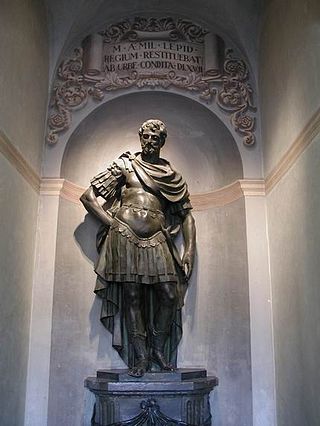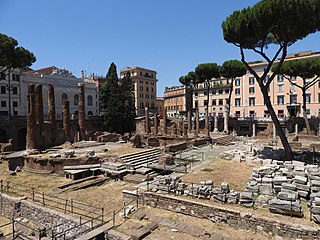
The Temple of Hercules Musarum (Aedes Herculis Musarum) was a Roman temple dedicated to Hercules Musarum ("Hercules of the Muses") located near the Circus Flaminius in the southern Campus Martius in ancient Rome. [1] [2]

The Temple of Hercules Musarum (Aedes Herculis Musarum) was a Roman temple dedicated to Hercules Musarum ("Hercules of the Muses") located near the Circus Flaminius in the southern Campus Martius in ancient Rome. [1] [2]
The temple was built by the consul Marcus Fulvius Nobilior, who conquered the Macedonian city of Ambracia in 189 BC. [3] It was probably completed and dedicated during his triumph in 187 BC. Having earned scorn for enriching himself by raiding Greek temples, Fulvius Nobilior supposedly erected a portico around an earlier temple of Hercules in the Campus Martius, most likely that of Hercules Magnus Custos ("Hercules the Great Guardian"). [4] He donated the copies of the fasti and statues he had taken from Ambracia, including a statue group of the Muses, [4] after which the temple became known as Hercules Musarum, a calque of the Greek Hercules Musagetes (Ηρακλής Μουσαγέτης, Hēraklḗs Mousagétēs), Hercules as leader of the Muses. The temple later became the home of the Roman poets' guild ( collegium poetarum). [5]
The Portico of Octavius (Porticus Octavia) was later built around the temple. Around 33–29 BC, Octavian and his stepbrother L. Marcius Philippus refurbished the portico and temple, after which the area was known as the Portico of Philippus (Porticus Philippi).
The temple has not survived but part of its floorplan is known from Fragment 33 of the 3rd century Forma Urbis Romae. [6]

Ambracia was a city of ancient Greece on the site of modern Arta. It was founded by the Corinthians in 625 BC and was situated about 11 km (7 mi) from the Ambracian Gulf, on a bend of the navigable river Arachthos, in the midst of a fertile wooded plain.

Marcus Aemilius Lepidus was a Roman consul, Pontifex Maximus, Censor and Princeps Senatus. A scion of the ancient Patrician gens Aemilia, he was most likely the son of Marcus Aemilius Lepidus, with his brothers being Lucius and Quintus.


Largo di Torre Argentina is a large open space in Rome, Italy, with four Roman Republican temples and the remains of Pompey's Theatre. It is in the ancient Campus Martius.
Marcus Fulvius Nobilior was a Roman general.

The Temple of Hercules Victor or Hercules Olivarius is a Roman temple in Piazza Bocca della Verità, the former Forum Boarium cattle market of ancient Rome. It is a tholos, a round temple of Greek 'peripteral' design completely surrounded by a colonnade. This layout caused it to be mistaken for a temple of Vesta until it was correctly identified by Napoleon's Prefect of Rome, Camille de Tournon.

The Porticus Octaviae is an ancient structure in Rome. The colonnaded walks of the portico enclosed the Temples of Juno Regina (north) and Jupiter Stator (south), as well as a library. The structure was used as a fish market from the medieval period up to the end of the 19th century.

The Porticus Octavia, also known as the Portico of Octavius, was a portico in ancient Rome built by Gnaeus Octavius in 168 BC to commemorate his capture of Perseus of Macedonia during the Third Macedonian War. It stood between the Theatre of Pompey and the Circus Flaminius beside the Porticus Metelli. Pliny describes it as a double portico with bronze Corinthian capitals, for which it was also called the Corinthian Portico. It may have been the earliest use of this architectural order in Rome and is possibly to be identified with remains on the Via S. Nicola ai Cesarini, represented in the Severan Marble Plan. Velleius Paterculus called it "by far the loveliest" of the porticoes of his time.

The Temple of Jupiter Stator, also known to the ancient Romans as the Temple of Jove Metellina and Metellus's Temple, was a temple dedicated to the Roman god Jupiter Stator. It was located beside the Temple of Juno Regina in the Porticus Octaviae in the southern Campus Martius before its destruction in the AD 64 Great Fire of Rome.

In ancient Roman religion, a sacellum is a small shrine. The word is a diminutive from sacrum. The numerous sacella of ancient Rome included both shrines maintained on private properties by families, and public shrines. A sacellum might be square or round.
The Porticus Argonautarum, also known as the Portico of Agrippa was a portico in ancient Rome.
The Porticus Catuli was a portico on the Palatine Hill in ancient Rome. It was a local landmark. It was built by Quintus Lutatius Catulus to commemorate his joint victory with Gaius Marius over the Cimbri at Vercellae.

Lucius Marcius Philippus was a Roman politician who was elected suffect consul in 38 BC. He was step-brother to the future emperor Augustus, as well as his uncle

In ancient Roman religion and myth, Hercules was venerated as a divinized hero and incorporated into the legends of Rome's founding. The Romans adapted Greek myths and the iconography of Heracles into their own literature and art, but the hero developed distinctly Roman characteristics. Some Greek sources as early as the 6th and 5th century BC gave Heracles Roman connections during his famous labors.

Fortuna Huiusce Diei was an aspect of the goddess Fortuna, known primarily for her temple in the Area Sacra di Largo Argentina at Rome. Cicero lists her among the deities who should be cultivated in his ideal state, because "she empowers each day". She thus embodies an important aspect of time as it figures in Roman religion: every day of the year had a distinct and potent nature, which the public priests were responsible for knowing and aligning the community with by means of the religious calendar.
The Temple of Hercules Custos was a Roman temple dedicated to 'Hercules the Guardian'. Its location is unknown and no remains have been found, although a Temple to Hercules linked to Lucius Cornelius Sulla was noted as standing in the region of the Esquiline Hill during the late 4th century.

The Temple of Juno Regina was a temple dedicated to the Roman goddess Juno Regina located near the Circus Flaminius in the southern Campus Martius of ancient Rome. It was solemnly vowed by the consul Marcus Aemilius Lepidus in 187 BC during his final battle against the Liguri and was consecrated and opened on 23 December 179 BC, while he was serving as censor. It was linked by a portico to a temple of Fortuna, possibly the Temple of Fortuna Equestris, and later joined by a temple of Jupiter Stator. Both temples were surrounded by the Portico of Metellus. The portico and both temples were rebuilt by Augustus as the Porticus Octaviae sometime after 27 BC.

The Temple of Neptune was an ancient Roman temple dedicated to Neptune on the Campus Martius near the Circus Flaminius in Rome.

The Regio IX Circus Flaminius is the ninth regio of imperial Rome, under Augustus's administrative reform. Regio IX took its name from the racecourse located in the southern end of the Campus Martius, close to Tiber Island.